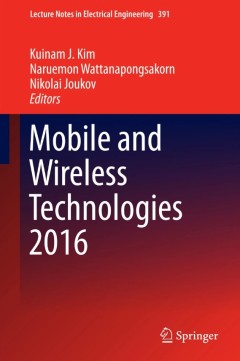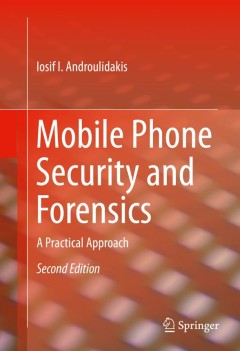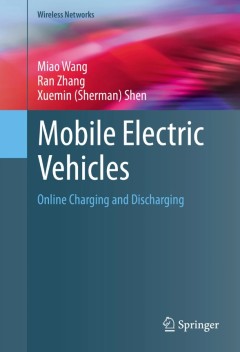Filter by

Mobile and Wireless Technologies 2016
This book presents the peer-reviewed contributions of ICMWT2016, an international conference devoted to mobile and wireless technology. Researchers and professionals from academia and industry met to discuss the cutting-edge developments in the field. The book includes papers on mobile and wireless networks, the increasingly important security issues, data management, as well as the latest deve…
- Edition
- 1
- ISBN/ISSN
- 978-981-10-1408-6
- Collation
- XIII, 252
- Series Title
- Lecture Notes in Electrical Engineering
- Call Number
- -

Modern Technologies for Landslide Monitoring and Prediction
Modern Technologies for Landslide Investigation and Prediction presents eleven contributed chapters from Chinese and Italian authors, as a follow-up of a bilateral workshop held in Shanghai on September 2013. Chapters are organized in three main parts: ground-based monitoring techniques (photogrammetry, terrestrial laser scanning, ground-based InSAR, infrared thermography, and GNSS networks), g…
- Edition
- 1
- ISBN/ISSN
- 978-3-662-45930-0
- Collation
- XII, 249
- Series Title
- Springer Natural Hazards
- Call Number
- -

Emerging Research in Computing, Information, Communication and Applications …
This proceedings volume covers the proceedings of ERCICA 2015. ERCICA provides an interdisciplinary forum for researchers, professional engineers and scientists, educators, and technologists to discuss, debate and promote research and technology in the upcoming areas of Computing, Information, Communication and their Applications. The contents of this book cover emerging research areas in field…
- Edition
- -
- ISBN/ISSN
- 978-981-10-0287-8
- Collation
- 111 b/w illustrations, 269 illustrations in colour
- Series Title
- -
- Call Number
- -

Emerging Research in Computing, Information, Communication and Applications …
This proceedings volume covers the proceedings of ERCICA 2015. ERCICA provides an interdisciplinary forum for researchers, professional engineers and scientists, educators, and technologists to discuss, debate and promote research and technology in the upcoming areas of Computing, Information, Communication and their Applications. The contents of this book cover emerging research areas in field…
- Edition
- -
- ISBN/ISSN
- 978-81-322-2553-9
- Collation
- 109 b/w illustrations, 257 illustrations in colour
- Series Title
- -
- Call Number
- -

Emerging Research in Computing, Information, Communication and Applications …
This proceedings volume covers the proceedings of ERCICA 2015. ERCICA provides an interdisciplinary forum for researchers, professional engineers and scientists, educators, and technologists to discuss, debate and promote research and technology in the upcoming areas of Computing, Information, Communication and their Applications. The contents of this book cover emerging research areas in field…
- Edition
- -
- ISBN/ISSN
- 978-81-322-2550-8
- Collation
- 87 b/w illustrations, 218 illustrations in colour
- Series Title
- -
- Call Number
- -

Modeling and Processing for Next-Generation Big-Data Technologies
This book covers the latest advances in Big Data technologies and provides the readers with a comprehensive review of the state-of-the-art in Big Data processing, analysis, analytics, and other related topics. It presents new models, algorithms, software solutions and methodologies, covering the full data cycle, from data gathering to their visualization and interaction, and includes a set of c…
- Edition
- 1
- ISBN/ISSN
- 978-3-319-09176-1
- Collation
- XX, 516
- Series Title
- Modeling and Optimization in Science and Technologies
- Call Number
- -

Mobile Phone Security and Forensics
Dr. Iosif I. Androulidakis has an active presence in the ICT security field having authored more than 90 publications (including 6 books) and having presented more than 120 talks and lectures in international conferences and seminars in 20 countries. Holding 2 Ph.Ds his research interests focus on security issues in PBXs (private telephony exchanges), where he has 20 years of experience, as…
- Edition
- 1
- ISBN/ISSN
- 978-3-319-29741-5
- Collation
- XI, 120
- Series Title
- -
- Call Number
- -

Mobile Networks for Biometric Data Analysis
This book showcases new and innovative approaches to biometric data capture and analysis, focusing especially on those that are characterized by non-intrusiveness, reliable prediction algorithms, and high user acceptance. It comprises the peer-reviewed papers from the international workshop on the subject that was held in Ancona, Italy, in October 2014 and featured sessions on ICT for health ca…
- Edition
- 1
- ISBN/ISSN
- 978-3-319-39698-9
- Collation
- IX, 323
- Series Title
- Lecture Notes in Electrical Engineering
- Call Number
- -

Mobile Electric Vehicles
This book examines recent research on designing online charging and discharging strategies for mobile electric vehicles (EVs) in smart grid. First, the architecture and applications are provided. Then, the authors review the existing works on charging and discharging strategy design for EVs. Critical challenges and research problems are identified. Promising solutions are proposed to accommodat…
- Edition
- 1
- ISBN/ISSN
- 978-3-319-25128-8
- Collation
- X, 73
- Series Title
- Wireless Networks
- Call Number
- -

Elements of Plasma Technology
This book presents some fundamental aspects of plasma technology that are important for beginners interested to start research in the area of plasma technology. These include the properties of plasma, methods of plasma generation and basic plasma diagnostic techniques. It also discusses several low cost plasma devices, including pulsed plasma sources such as plasma focus, pulsed capillary disch…
- Edition
- 1
- ISBN/ISSN
- 978-981-10-0117-8
- Collation
- 12 b/w illustrations, 93 illustrations in colour
- Series Title
- -
- Call Number
- -
 Computer Science, Information & General Works
Computer Science, Information & General Works  Philosophy & Psychology
Philosophy & Psychology  Religion
Religion  Social Sciences
Social Sciences  Language
Language  Pure Science
Pure Science  Applied Sciences
Applied Sciences  Art & Recreation
Art & Recreation  Literature
Literature  History & Geography
History & Geography